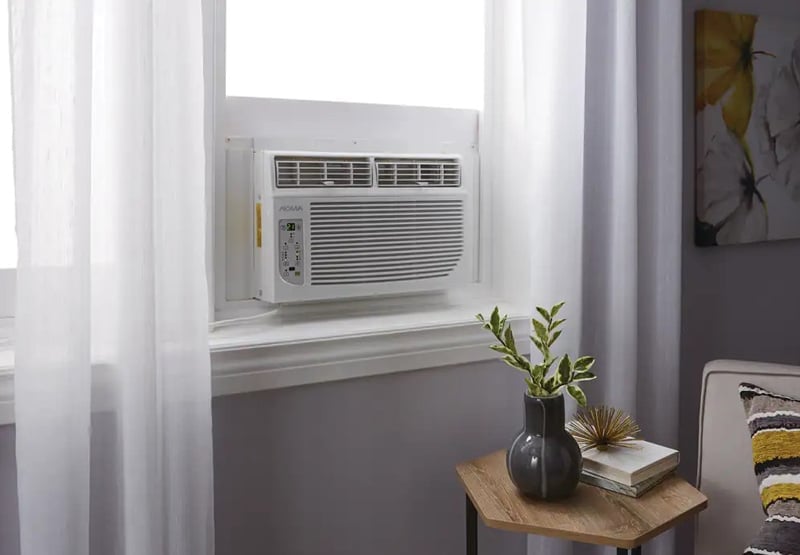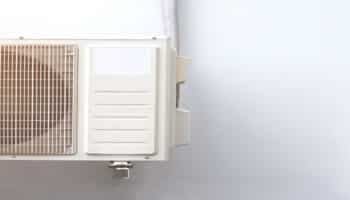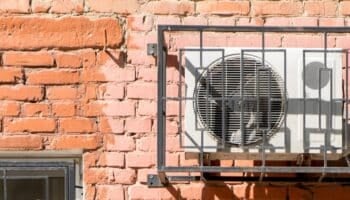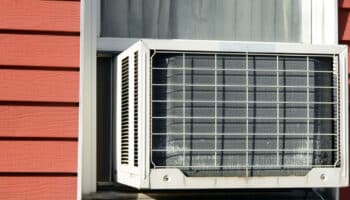We've independently reviewed this article to make sure it's as accurate as we can make it.
To find out more about our article creation and review process, check out our editorial guidelines.
Feeling ice cold on a hot summer day might be welcome but having your window air conditioner freezing over? Not so much.
Why do window AC units freeze over? An ice build-up might be the result of an oversized unit, running it when it’s cool outside, a faulty compressor, refrigerant leaks, frozen coils, and even a dirty filter. Fortunately, you can address and fix several of these issues yourself.
And we’ll tell you how!
So let’s get started.
What You’ll Need
Depending on the reason your air conditioner is freezing over, there will be different methods to diagnose and fix it. Determine what your issue is and then use the appropriate tools
- Screwdriver
- Coil cleaner
- Brush
- Fin tool
- Garden hose
How to Fix a Window Air Conditioner That’s Freezing Over
The following will take you through a variety of scenarios that could cause a frozen air conditioner and show you what to do to fix them.
Dirty Air Filters: Cause & Fix
Lack of air filter maintenance is one of the leading causes of most air conditioner problems. The longer you go without either cleaning or changing an air filter the deeper the layer of dust, debris, pet hair, and whatever else builds upon it.
That sick layer of dirt obstructs airflow. And airflow is necessary for your air conditioner to run. Not only will your blower motor try to work harder to push air through the filter and eventually burn out, but the lack of airflow can also cause ice to build up on the coils.
What you need to do.
Step 1
Unplug your air conditioner
Step 2
Remove the front grill according to the manufacturer’s instructions
Step 3
Remove the dirty filter and replace it with a new one that matches the manufacturer’s specifications(or if reusable, clean the filter)
Step 4
Replace the grill and plug your air conditioner back in
Closed Vent: Cause & Fix
This problem has to do with airflow as well. To properly cool your home, an air conditioner needs sufficient airflow. If you have your AC running but close the vents on the front panel, you’re holding back all the cold air the unit has created.
Fortunately, the fix is simple.
Step 1
If you’re closing vents because you’re too cold, adjust the thermostat or turn off the unit

Step 2
If you’ve adjusted the thermostat, open the vents back up
Dirty Coils: Cause & Fix
Window air conditioners have two coils, a condenser coil, and an evaporator coil. And just like dirt can build up on a filter and obstruct airflow, dirt that builds up on your condenser coil can make it freeze up. But in order for it to work properly, it needs to be warm—it absorbs heat from your home, and it can’t do that if it’s frozen.
A clean air conditioner helps with efficiency while dirty components can make it stop running. Efficiency means you’ll have lower running costs!
Here are the steps to clean your coils. If you do this at least once a year, freezing coils shouldn’t happen—assuming the cause is a buildup of dirt.
Step 1
Unplug and remove your air conditioner from the window
Step 2
Take it outside and place it somewhere flat and stable
Step 3
Following your manufacturer’s guidelines, remove the front grill, filter, and cabinet
Step 4
Refer to your manual for your condenser coil placement
Step 5
Inspect the coils for large debris and remove it by hand and then use a brush or vacuum to remove loose dust. You can buy something called a coil brush that is specifically for this task.
Step 6
If you have any bent fins around your coils, you can use a fin tool to straighten them out.
Step 7
Use your garden hose on a low-pressure setting to rinse off the coils. If you can’t take your unit outside, you can use a spray bottle and cloth to wet the coils
Step 8
Use the correct coil cleaner—coils can be copper or aluminum, so make sure the cleaner you have is safe for one or the other or both. Apply a layer of the cleaner over the coils and it will foam and lift off surface grime.
Most general cleaners will be fine, just be careful not to use condenser coil cleaner on an evaporator coil. (The condenser coils are on the rear facing outside, and evaporator coils on the front).
Alternatively, if you have aluminum coils, you can simply use a mix of mild soap, such as dish detergent, and warm water in a spray bottle.
Step 9
Let the foam sit according to the recommendation on the can
Step 10
If you have a rinsing foam, rinse it off using a low-pressure garden hose. Optionally, you can buy a type of cleaner that doesn’t require rinsing.
Step 11
Let your air conditioner sit out and completely air dry—this could be about an hour, depending on weather conditions
Step 12
Reassemble and reinstall your air conditioner
Clogged Condensate Drain: Cause & Fix
Nearly all air conditioners of any type will create condensation. With window air conditioners, the condensate collects in a pan that’s located at the bottom of the unit.
If the drain hole—if your unit has one—gets clogged up, water will sit and eventually freeze, leading to the coils freezing over as well.
Note that many newer window air conditioners don’t have a drain hole. Instead, the water is picked up by an attachment to the fan and thrown onto the condenser coils in order to keep them cool. If this is the type of AC you have and the water is backing up, you may have a problem with your fan, so check the fan section below.
Alternatively, if your fan seems to be running fine, try the fix in the following video for units without a drain hole.
If you have a drain hole that isn’t draining properly, do the following.
Step 1
Before removing the unit from the window, remove the drain plug and allow the water to drain.
Step 2
If no water drains after removing the plug, remove the unit from the window and place it somewhere sturdy.
Step 3
Remove the front grill, the filter, and then the entire cabinet following the manufacturer’s instructions.
Step 4
Unscrew and remove the drain pan and then check for and remove any visible debris collected in the bottom. If you’ve taken the air conditioner outside, use a low-pressure garden hose to flush and drain the pan. A bottle brush is also helpful.
Step 5
Reassemble and reinstall your air conditioner, making sure to preserve the slight downward tilt that’s typically required in the manufacturer’s installation instructions.
Oversized Air Conditioner: Cause & Fix
Remember Goldilocks and the chair/bed/bowl that was just the right size? Well, your air conditioner needs to be just the right size too. Either too big or too small, and you are going to have a lot of problems.
Not that we don’t mean physical size. The number of BTUs should match the size of the area you’re trying to cool.
If your air conditioner is too big, it will short cycle. That means it’s kicking in more than it should.
Unfortunately, if this is the cause of your AC freezing over, there isn’t much you can do to correct the issue—other than buying a smaller unit for the area.
Refrigerant Leak: Cause & Fix
If you see ice forming on the condenser coils this is often a sign of a refrigerant leak, especially if you are also hearing a hissing or bubbling sound coming from the unit when it isn’t running.
If you have a refrigerant leak, this is very dangerous.
Step 1
Remove the air conditioner from the window and take it outside

Step 2
Completely air out your home
Step 3
Call in a repair technician to service your air conditioner
Step 4
Do not attempt to fix the refrigerant leak, since only licensed technicians are legally allowed to handle this dangerous substance
Issues With the Fan: Cause & Fix
Over time, your air conditioner’s fan will develop wear and tear, and if you have a newer fan that doesn’t drain condensate, a symptom of fan problems could be ice buildup.
Many newer model window air conditioners handle condensation using the fan. An attachment to the fan lifts water from the pan and throws it onto the coils. The premise here is that this increases efficiency by cooling the coil down.
However, if condensate just builds up in the pan, that can cause the coils to freeze over.
Here’s what to do if this is your situation.
Step 1
Unplug and remove your air conditioner from the window
Step 2
Find a level, sturdy place to sit it down
Step 3
Following the manufacturer’s guidelines, remove the front grill, the filter, and then the entire cabinet
Step 4
Using a brush, cloth, and or vacuum, remove all dirt and debris from the fan blades.
Step 5
Inspect the blades for any visible damage
Step 6
Try to rotate the fan by hand, and determine whether or not it’s obstructed by anything when in motion
Step 7
Make any necessary adjustments
Step 8
Reassemble And reinstall your air conditioner
Conclusion
if your air conditioner is freezing over, in a lot of situations, it should be something you can fix yourself.
Unfortunately, in a few cases, such as an oversized air conditioner or a refrigerant leak, there’s not much you can do. You’ll either need to buy a new air conditioner or have it serviced by a licensed technician.
However, if you’ve diagnosed any of the following, this is a DIY project.
- Dirty air filter
- Closed or obstructed vents
- Dirty coils
- Clogged condensate drain
- Issues with the fan
Hopefully, this article has helped you pinpoint your issue and you can fix it.
Thanks for reading through! While you’re here, why not take a look at our related posts below and see if there’s anything else we can help you with?







